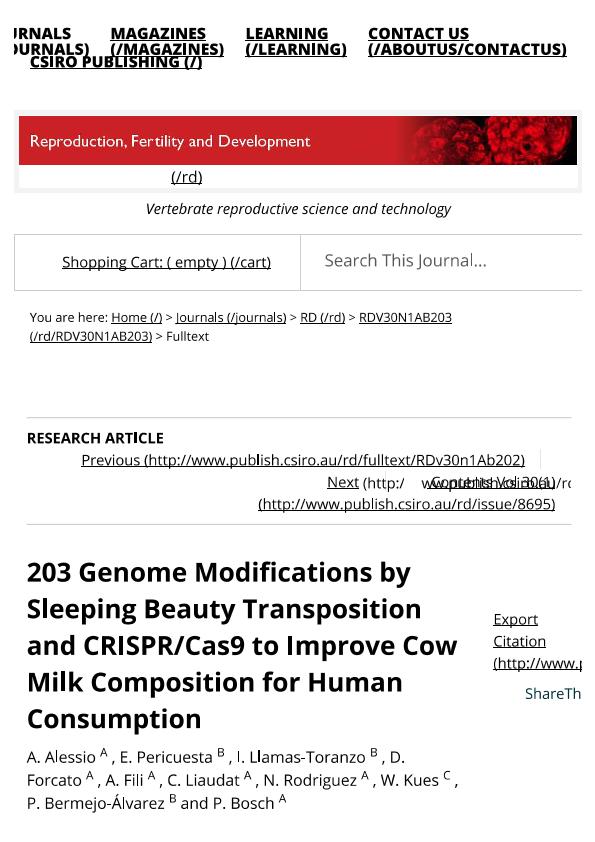Mostrar el registro sencillo del ítem
dc.contributor.author
Alessio, Ana Paula

dc.contributor.author
Pericuesta, Eva
dc.contributor.author
Llamas Toranzo, Ismael
dc.contributor.author
Forcato, Diego Oscar

dc.contributor.author
Bosch, Pablo

dc.date.available
2018-12-10T18:01:08Z
dc.date.issued
2017-12
dc.identifier.citation
Alessio, Ana Paula; Pericuesta, Eva ; Llamas Toranzo, Ismael; Forcato, Diego Oscar; Bosch, Pablo; Genome modifications by sleeping beauty transposition and CRISPR/Cas9 to improve cow milk composition for human consumption; Csiro Publishing; Reproduction Fertility and Development; 12-2017
dc.identifier.issn
1031-3613
dc.identifier.uri
http://hdl.handle.net/11336/66190
dc.description.abstract
Genome manipulation of cattle represents a powerful tool to increase the nutritional value and reduce allergenicity of cow milk for human consumption. This could be accomplished by improving the amount of polyunsaturated fatty acids (ω-3 and ω-6) and simultaneously abolishing β-lactoglobulin (BLG), a potent allergen for predisposed humans. The aim of this study was to introduce the sequence for a desaturase construct (mFAT-2, from C. elegans), which is able to catalyse the synthesis of ω-3 and ω-6 fatty acids, into the bovine genome by Sleeping Beauty (SB) transposition, and simultaneously knocking out the bovine β-lactoglubulin gene using CRISPR/Cas9 system. The sgRNA (AAGTGCCTCCTGCTTGCCC) targeted to BLG exon 1 was synthesised as an oligo linker and cloned into the px459-Cas9. The mutation activity of the designed sgRNA at the target locus was determined by T7 endonuclease assay I (T7EI) mismatch detection assay. Briefly, bovine fetal fibroblasts (BFF) were seeded at 0.5 × 105 cells per well of a 24-well plate in triplicate, when the cells reached 80% confluence (12?24 h), cultures were transfected with 1 μg of px459-Cas9::BLG plasmid co-expressing Cas9 and sgRNA using polyethylenimine reagent (PEI; 3 ng μL−1). After 3 days of puromycin selection, genomic DNA from transfected cells were extracted and the sequence of interest was PCR-amplified and digested by T7EI restriction enzyme. Digestion products showed a mutation efficiency at the target locus of 29%. Subsequently, we chemically cotransfected 0.5 × 105 BFF with 0.5 μg of knockout vector (px459-Cas9::BLG) and 0.5 μg of SB plasmids (carrying mFAT-2 cDNA for mammary gland-specific expression) using 3 ng μL−1 PEI in triplicate. At 48 h post-transfection, cell cultures were subjected to 3 days of puromycin and 21 days of neomycin selection. PCR analysis of antibiotic resistant colonies revealed the presence of mFAT-2 transgene in almost 70% of the analysed cells lines. Genotyping of BLG exon 1 was performed by direct sequencing of PCR amplicons using primers flanking the target site. Despite the appreciable gene mutation activity of the sgRNA sequence previously determined by T7EI assay (29%), none of the cell lines analysed showed modification in the BLG target locus. We speculate that the SB vector might have disrupted the activity of targeting vector. We are currently performing additional experiments to accomplish gene addition (mFAT) and gene knockout (BGL) in one step using these highly efficient and precise transgenic tools. Genetically modified cells will be used as nuclear donor to produce transgenic cows by somatic cells nuclear transfer.
dc.format
application/pdf
dc.language.iso
spa
dc.publisher
Csiro Publishing

dc.rights
info:eu-repo/semantics/openAccess
dc.rights.uri
https://creativecommons.org/licenses/by-nc-sa/2.5/ar/
dc.subject
Cow Milk Composition
dc.subject
Crispr/Cas9
dc.subject
Sleeping Beauty Transposition
dc.subject
Genome Modifications
dc.subject.classification
Otras Biotecnología Agropecuaria

dc.subject.classification
Biotecnología Agropecuaria

dc.subject.classification
CIENCIAS AGRÍCOLAS

dc.title
Genome modifications by sleeping beauty transposition and CRISPR/Cas9 to improve cow milk composition for human consumption
dc.type
info:eu-repo/semantics/article
dc.type
info:ar-repo/semantics/artículo
dc.type
info:eu-repo/semantics/publishedVersion
dc.date.updated
2018-12-06T14:45:44Z
dc.identifier.eissn
1448-5990
dc.journal.pais
Australia

dc.journal.ciudad
Collingwood
dc.description.fil
Fil: Alessio, Ana Paula. Universidad Nacional de Río Cuarto. Facultad de Ciencias Exactas Fisicoquímicas y Naturales. Departamento de Biología Molecular; Argentina
dc.description.fil
Fil: Pericuesta, Eva. Dpto. de Reproducción Animal, Inia; España
dc.description.fil
Fil: Llamas Toranzo, Ismael. Dpto. de Reproducción Animal, Inia; España
dc.description.fil
Fil: Forcato, Diego Oscar. Universidad Nacional de Río Cuarto. Facultad de Ciencias Exactas Fisicoquímicas y Naturales. Departamento de Biología Molecular; Argentina. Consejo Nacional de Investigaciones Científicas y Técnicas; Argentina
dc.description.fil
Fil: Bosch, Pablo. Consejo Nacional de Investigaciones Científicas y Técnicas; Argentina. Universidad Nacional de Río Cuarto. Facultad de Ciencias Exactas Fisicoquímicas y Naturales. Departamento de Biología Molecular; Argentina
dc.journal.title
Reproduction Fertility and Development

dc.relation.alternativeid
info:eu-repo/semantics/altIdentifier/url/http://www.publish.csiro.au/rd/RDv30n1Ab203
dc.relation.alternativeid
info:eu-repo/semantics/altIdentifier/doi/http://dx.doi.org/10.1071/RDv30n1Ab203
Archivos asociados
